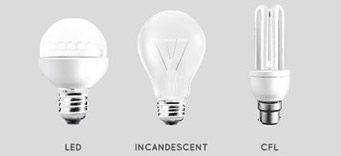Why LED?
Almost half of residential power bills are lighting. By making the switch to LED you have the ability to reduce that portion of your power usage by 50 to 90%, recouping the cost of switching in the first year.
We definitely are not the inventors of LED technology and neither are we the earliest adopters. LED technology decreases the amount of power consumed by an incandescent (or regular) light bulb by 90%. The mercury laden potentially dangerous compact fluorescent, often touted as the solution to our ever-expanding power bills, still consumes 50% more power than LED. Most consumers do not realize this, nor do they realize how easily this could be addressed in their home or business.
We know much more about LED technology now than we did in the past few years. We have made the switch ourselves so our own homes use LED. We have grown accustomed to and like the clean white light. We have switched over a few small businesses and celebrate that their power bills have gone down $200 per month. The savings far outweighs the initial start-up cost to make the switch. A sample home could save almost $100 per month on a residential power bill.
POWER CONSUMPTION
Halogen, incandescent and mercury halide are a few of the antique bulbs that consume 90% more power than an LED bulb/fixture producing the same amount of light.
POWER SAVINGS
Regular fluorescent lights use twice as much power as LED tubes to produce half the light. They are two and a half times brighter than most fluorescents – purchasing two tubes for a four tube fixture is often enough. If you drive around at night and see all of the lights left on, you can begin to imagine the potential savings in power.

HEAT PRODUCTION
Large wattage bulbs and smaller incandescent bulbs produce copious amounts of heat, which will end up costing you more money in the warmer months by way of air conditioning. The LED equivalent produces far less heat, which will save money in the long run.
A BRIGHTER FUTURE
Have you ever flown into a city at night? You can actually tell which lights are LED as they are the small spots of exceptionally bright white light. Only one tenth of the actual power being used to produce the rest of the light is necessary.
What You Should Know About Lighting Your Home With LED Bulbs



 How does LED compare?Find Out
How does LED compare?Find Out

